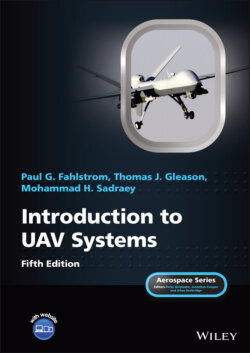Читать книгу Introduction to UAV Systems - Mohammad H. Sadraey - Страница 58
2.3.1 Micro‐UAVs
ОглавлениеA new class of UAVs called micro‐UAVs is of growing interest, which have the attributes of large insects and very small birds. This is a term for a class of UAVs that are, as of this writing, still largely in the conceptual or early stages of development. They are envisioned to range in size from a large insect to a model airplane with a one‐inch wingspan. The advent of the micro‐UAV produces a whole new series of challenges associated with scale factors, particularly micro‐autopilot and control in atmospheric phenomena such as wind and gust.
Although there are still no active micro‐UAVs in existence, DARPA have attempted a program to develop micro‐UAVs including a flapping wing. The world’s smallest and lightest micro‐helicopter UAV was experimented and demonstrated by Japanese Epson Corporation – with a prop diameter of 130 mm and a mass of 8.9 g. Insight into the art of bird‐size UAVs may be obtained from Hank Tennekes’ book, The Simple Science of Flight from Insects to Jumbo Jets [7].
Assuming that payload and power‐plant problems can be solved, the low wing loading of these types of air vehicles may prohibit operation in all except the most benign environmental conditions (e.g., no wind). Some of these problems, and solutions, will be discussed in Part Two of this book.
